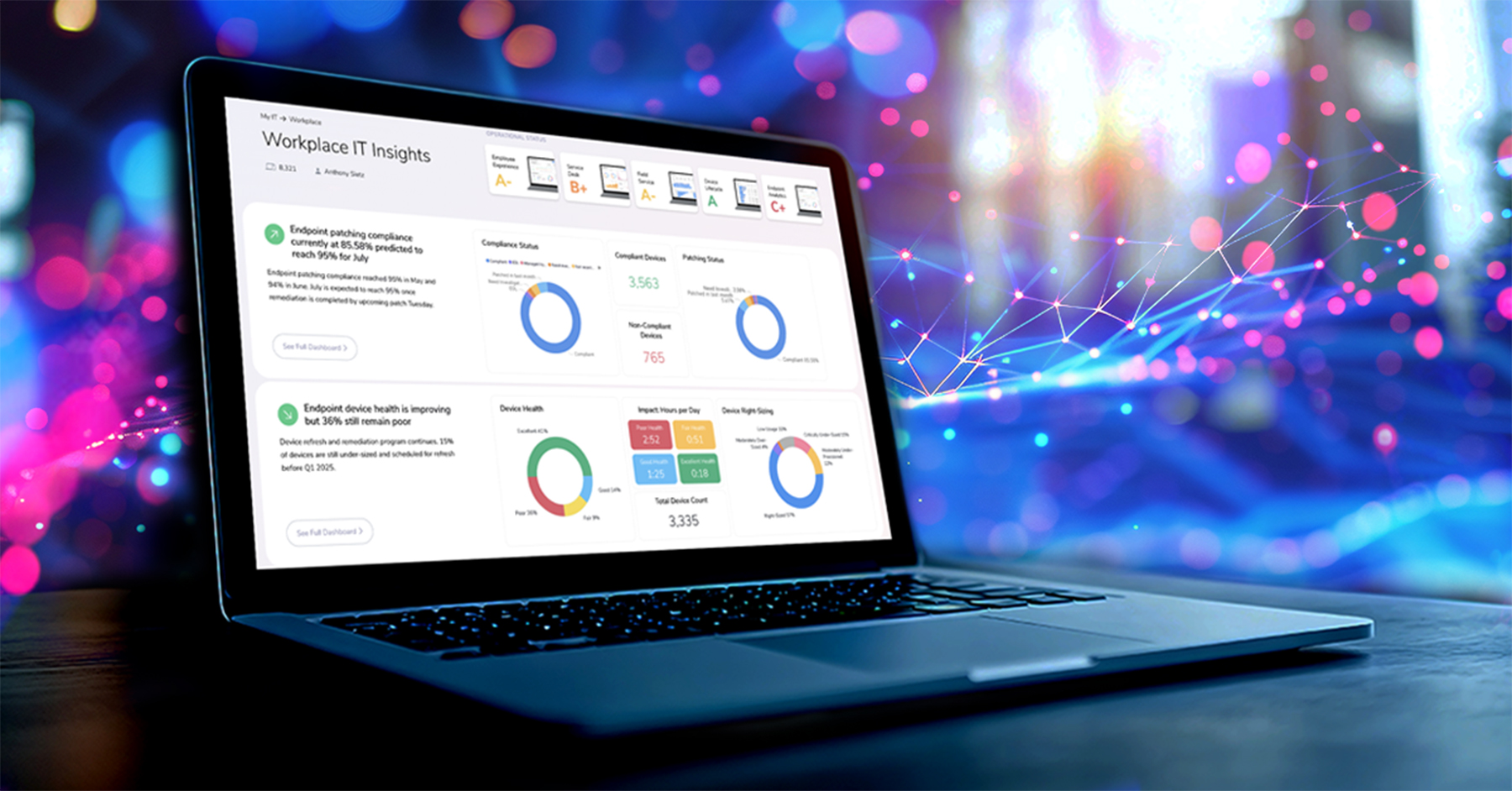- Managed Infrastructure and Cloud Services
- Advanced Technology

You don’t see much about Artificial Intelligence for IT Operations (AIOps) in today’s headlines. News about AI leans toward its more controversial capabilities to create content and (creepy) “art.” And the world wonders, is this what we want from AI?
When the camera was invented in the 1800s, a critic decried photography as “the mortal enemy of all art,” echoing fears of contemporary painters that it would make them irrelevant. Luckily, that was far from what happened — photography inspired Impressionism and the modern art movement.
Just like photography spurred artists to new levels of creativity, AI is at its best when it builds on our human capabilities — freeing us from drudgery and allowing us more time for creative, challenging, and fulfilling work. AIOps, isn’t intended to displace IT teams but rather help them better cope with the significant issues they face today:
- Sorting through overwhelming infrastructure data from many sources
- Ever-present and escalating cyber threats
- An ongoing shortage of IT talent
Successful AIOps Hinge on Integrating the Right Toolsets
This blog is part two of our more in-depth look at how AIOps works. As we discussed previously, the key to a successful implementation is integrating the right toolsets with your infrastructure to enable three main functionalities:
- Data ingestion from across IT domains
- Analysis, correlation, and recommendations
- Fixing the issue (through automated and/or human intervention) and proactive remediation
In this blog, we’ll take a closer look at the final part of the process in an advanced AIOps implementation: fixing the issue.
Enable Your IT Teams with Automated Remediation and Better Insights
Automated Remediation
It’s possible for AIOps implementations only to provide monitoring and make recommendations, but this fails to realize its full benefits. A more sophisticated implementation includes the capability for automated responses through an execution engine.
This provides some key advantages:
- Rather than waiting on human engineers to respond, incidents can be resolved more quickly, helping improve IT operations and, by extension, the user experience.
- AIOps tools can use historical data to improve automated remediation over time, growing more effective the longer the tools are in place.
This doesn’t mean handing over complete control for incident response. Policies can be set to configure how AIOps tools respond in various scenarios. For example, adjustments to specific infrastructure components, such as a critical server, could require review and approval from a human engineer.
Better Decision-Making and Proactive Remediation
In order to have a strategic rather than reactive approach to maintaining effective and efficient IT operations, you need to be able to see the big picture. Today, that’s almost impossible without AIOps. The days of searching through log files to identify possible issues are gone. It’s no longer humanly possible to deal with the vast amounts of data from the metrics, logs, traces, emails, and tickets in a typical enterprise infrastructure, especially when functions may be siloed and perhaps come from different providers.
A well-integrated AIOps platform can help with these challenges by:
- Determining a model of normal operating parameters for a system and then monitoring for anomalies. Anomalies can then either alert the right IT operators so they can work to resolve an issue before it happens or trigger an automation, for example, starting other instances of an in-demand application during predicted spikes in use.
- Creating an accurate topology that provides real-time insight into the state of critical systems and services so IT teams can focus on innovation rather than just responding to the everyday problems inherent to complex IT operations.
Get Strategic About IT Operations
In this blog and the last, we’ve looked at how AIOps can help you cut through the noise created by overwhelming amounts of data and alerts so you can get to the crux of IT operations issues and solve them proactively.
Next, we’ll finish our series by showing how an experienced provider like Compucom can help you go beyond the buzzword to a truly effective implementation and hear some real-world success stories.
In this series:
RecenT

Future-Ready IT: Strategies to Optimize, Adapt, and Lead Through Uncertainty

Reimagining IT with the FLO Framework: Inside Compucom’s Geordi Center for Interactive Managed Services and Digital Workplace Solutions

Opportunity in Uncertainty: Optimize Your Remote, Hybrid, or In-Office Setup

9 Ways Strategic IT Staffing Empowers Organizations

Case Studies: Asset Intelligence and Endpoint Compliance Made Easy

AI and the Enterprise: The Future of IT Management
TOPICS
How AIOps Works: Continually Smarter & More Effective IT Operations
- Managed Infrastructure and Cloud Services
- Advanced Technology
You don’t see much about Artificial Intelligence for IT Operations (AIOps) in today’s headlines. News about AI leans toward its more controversial capabilities to create content and (creepy) “art.” And the world wonders, is this what we want from AI?
When the camera was invented in the 1800s, a critic decried photography as “the mortal enemy of all art,” echoing fears of contemporary painters that it would make them irrelevant. Luckily, that was far from what happened — photography inspired Impressionism and the modern art movement.
Just like photography spurred artists to new levels of creativity, AI is at its best when it builds on our human capabilities — freeing us from drudgery and allowing us more time for creative, challenging, and fulfilling work. AIOps, isn’t intended to displace IT teams but rather help them better cope with the significant issues they face today:
- Sorting through overwhelming infrastructure data from many sources
- Ever-present and escalating cyber threats
- An ongoing shortage of IT talent
Successful AIOps Hinge on Integrating the Right Toolsets
This blog is part two of our more in-depth look at how AIOps works. As we discussed previously, the key to a successful implementation is integrating the right toolsets with your infrastructure to enable three main functionalities:
- Data ingestion from across IT domains
- Analysis, correlation, and recommendations
- Fixing the issue (through automated and/or human intervention) and proactive remediation
In this blog, we’ll take a closer look at the final part of the process in an advanced AIOps implementation: fixing the issue.
Enable Your IT Teams with Automated Remediation and Better Insights
Automated Remediation
It’s possible for AIOps implementations only to provide monitoring and make recommendations, but this fails to realize its full benefits. A more sophisticated implementation includes the capability for automated responses through an execution engine.
This provides some key advantages:
- Rather than waiting on human engineers to respond, incidents can be resolved more quickly, helping improve IT operations and, by extension, the user experience.
- AIOps tools can use historical data to improve automated remediation over time, growing more effective the longer the tools are in place.
This doesn’t mean handing over complete control for incident response. Policies can be set to configure how AIOps tools respond in various scenarios. For example, adjustments to specific infrastructure components, such as a critical server, could require review and approval from a human engineer.
Better Decision-Making and Proactive Remediation
In order to have a strategic rather than reactive approach to maintaining effective and efficient IT operations, you need to be able to see the big picture. Today, that’s almost impossible without AIOps. The days of searching through log files to identify possible issues are gone. It’s no longer humanly possible to deal with the vast amounts of data from the metrics, logs, traces, emails, and tickets in a typical enterprise infrastructure, especially when functions may be siloed and perhaps come from different providers.
A well-integrated AIOps platform can help with these challenges by:
- Determining a model of normal operating parameters for a system and then monitoring for anomalies. Anomalies can then either alert the right IT operators so they can work to resolve an issue before it happens or trigger an automation, for example, starting other instances of an in-demand application during predicted spikes in use.
- Creating an accurate topology that provides real-time insight into the state of critical systems and services so IT teams can focus on innovation rather than just responding to the everyday problems inherent to complex IT operations.
Get Strategic About IT Operations
In this blog and the last, we’ve looked at how AIOps can help you cut through the noise created by overwhelming amounts of data and alerts so you can get to the crux of IT operations issues and solve them proactively.
Next, we’ll finish our series by showing how an experienced provider like Compucom can help you go beyond the buzzword to a truly effective implementation and hear some real-world success stories.
In this series:
Recent Blogs

Future-Ready IT: Strategies to Optimize, Adapt, and Lead Through Uncertainty

Reimagining IT with the FLO Framework: Inside Compucom’s Geordi Center for Interactive Managed Services and Digital Workplace Solutions

Opportunity in Uncertainty: Optimize Your Remote, Hybrid, or In-Office Setup

9 Ways Strategic IT Staffing Empowers Organizations

Case Studies: Asset Intelligence and Endpoint Compliance Made Easy




